Chapter: Nutrition and Diet Therapy: Planning a Healthy Diet
U.S. Cultural Dietary Influences
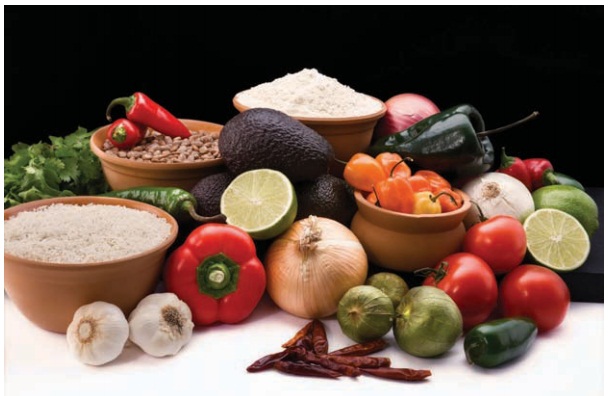
U.S. CULTURAL DIETARY
INFLUENCES
American cuisine
(cooking style) is a marvelous composite of countless national, regional,
cultural, and religious food customs. Consequently, categorizing a client’s
food habits can be difficult. Nevertheless, it is sometimes helpful to be able
to do so to a certain extent. People who are ill commonly have little interest
in food. Some-times comfort foods (foods that were familiar to them during
their childhood) are more apt to tempt them than other types. The following
section briefly discusses some food patterns typical of various cultures,
regions, and countries. Of course, there can be and usually are enormous
variations within any one classification.
Native American Influence
It is thought that approximately half of the edible plants commonly eaten in the United States today originated with the Native Americans. Examples are corn, potatoes, squash, cranberries, pumpkins, peppers, beans, wild rice, sunflower seeds, sweet potatoes, avocados, papayas, and cocoa beans (Figure 2-3). In addition, wild fruits, game, and fish are also popular.
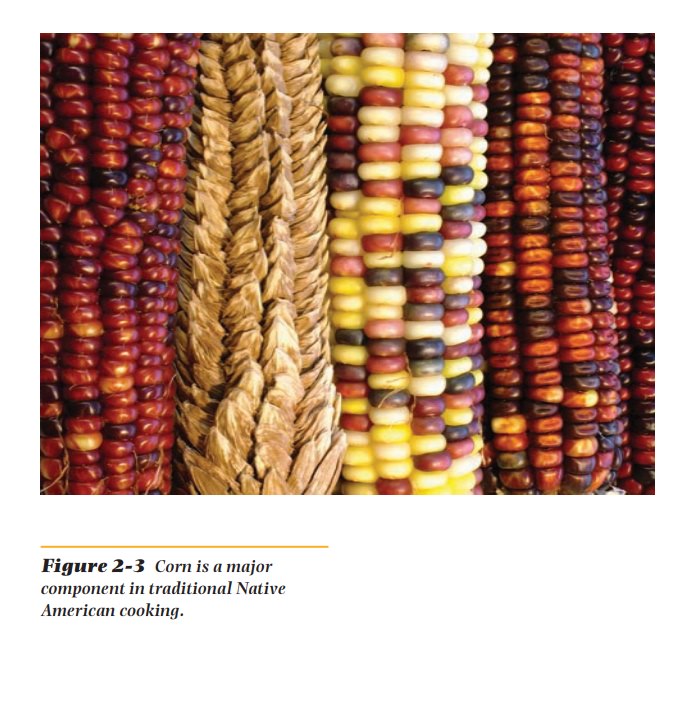
Foods are commonly pre-pared as soups and
stews or are dried. The original Native American diets were probably more nutritionally
adequate than are current diets, which frequently consist of too high a
proportion of sweet and salty, snack-type low-nutrient-dense foods. Native
American diets today may be deficient in calcium, vitamins A and C, and
riboflavin.
U.S. Southern Influences
The foods of the South
are as diverse as the people who settled the southern United States. Food
influenced by the South is so much a part of our national food culture that you
probably have eaten many of these foods without even realizing their origin.
African American Influence.Down-home breads such as corn-bread, biscuits, and cracklin’ bread are served with most meals. Collard, turnip, and mustard greens are prepared with fatback (a cut along the back of pigs) for flavor. Black-eyed peas, okra, sweet potatoes, peanuts, corn, green beans, hot and sweet peppers, lima beans, and rice are an important part of African American heritage (Figure 2-4). Pork, chicken, and fried fish are served of-ten. The term soul food was created in the 1960s to put emphasis on African American foodways (the food traditions or customs of a group of people) and preparation styles. Too much fat and sodium are consumed. This diet has too many carbohydrates but could be deficient in iron, calcium, fiber, potassium, and vitamin C.
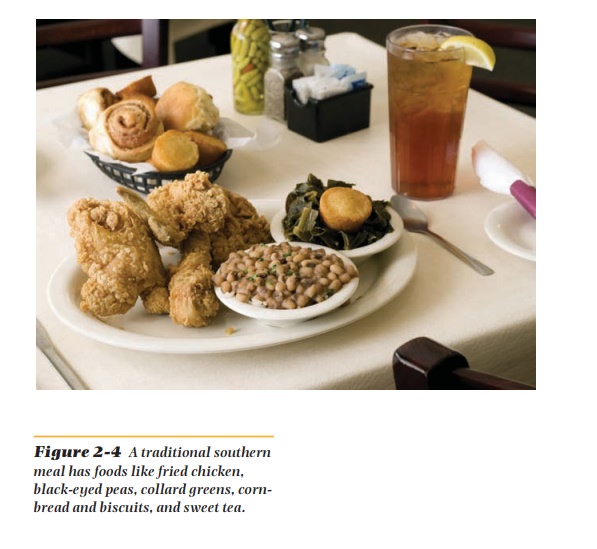
French American Influence.Cajun and Creole
cuisine is nativeto the “bayou” country in Louisiana and is a fusion of French and Spanish
cooking. Cajuns lived off the land and waterways. Cajun cooks use wild game,
seafood, vegetables, herbs, rice, tomatoes, sausage, hot peppers, and crawfish
(resembling small lobsters) (Figure 2-5). Cajuns usually make their meals in
one pot. Creole cooking uses many of the same foods but adds rich sauces that
increase calories. Calcium and vitamins D, E, and C could be lacking in their
diets, so the addition of fruit is needed.
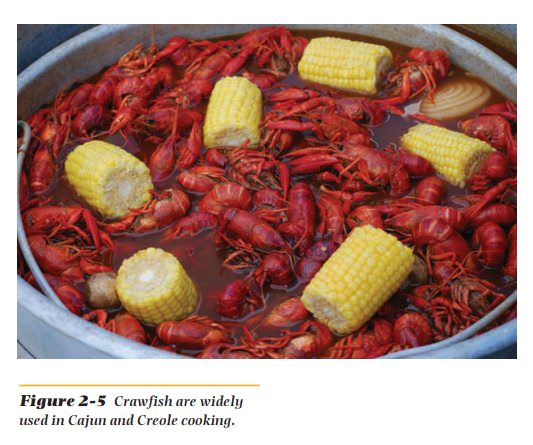
Spanish Influences
The Spaniards were
great seafaring explorers. They were responsible for find-ing and naming most
of the islands in the Caribbean, along with Mexico and the west coast of South
America. The Spanish and the natives who inhabited these countries have also
greatly influenced our cuisine.
Mexican Influence.Mexican food is a combination of Spanish andNative American. Beans, rice, tomatoes, onions, jalapenos, other chilies, and masa harina (traditional flour made from field corn) are staples for Hispan-ics. Corn tortillas are made from masa harina and are used as bread as well as stuffed with cheese, beef, pork, and other ingredients to make enchilads. Pork, goat, garlic, wheat and frijoles refritos (refried beans), avocados, and cheese are common foods (Figure 2-6). Flan, a custardlike pudding with caramel sauce, is a favorite dessert. The diet is lacking in vitamin C, and green and yellow vegetables and fruits. Cheese supplies some calcium in the diet, but calcium intake is low because of lactose intolerance (the body’s inability to digest the lactose in milk and some milk products).
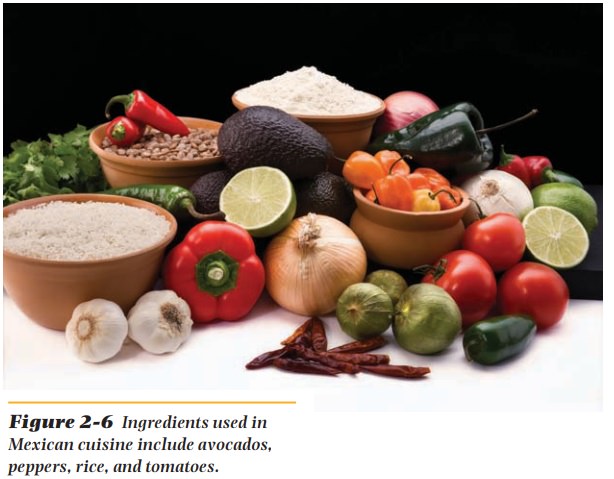
Puerto Rican Influence.Puerto Rican
cuisine has been influencedby the Spanish, African, and Taino Indians (first
inhabitants). Some of the foods in their diet are corn, wheat, seafood, beef,
pork, rice, olive oil, chicken, pinto beans, and okra. Plantains, green
bananas, white and yellow sweet potatoes, chayote squash, taro, and breadfruit
are starchy vegetables and are eaten often. Tropical fruits like pineapple,
mango, papayas, guava, and coconut are used often in desserts (Figure 2-7).
Traditional desserts includes flan, sweet potato balls with cinnamon, cloves
and coconut, and guava jelly served with white cheese. From a nutrition
standpoint, milk is not consumed often enough. Increased consumption of
nonstarchy vegetables would add variety and elimi-nate some carbohydrates.
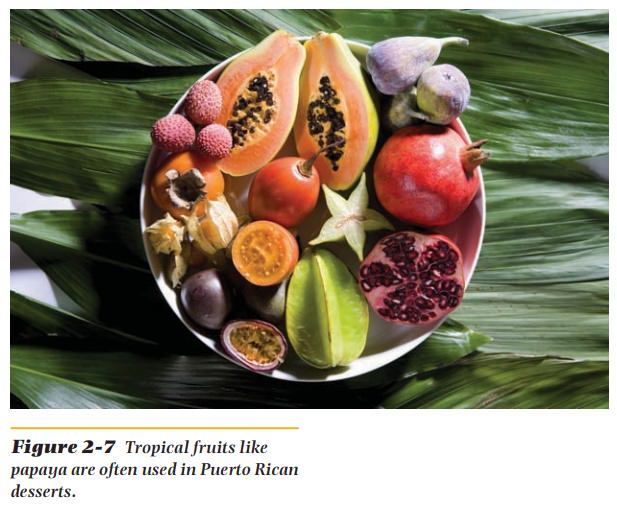
Mediterranean Influences
The
Mediterranean diet is the healthiest in the world (Figure 2-8). The most
important aspects of the Italian Mediterranean diet are the use of olive oil
and the eating of small portions. The Italians on the Mediterranean have the lowest
incidence of heart disease because of their eating habits.
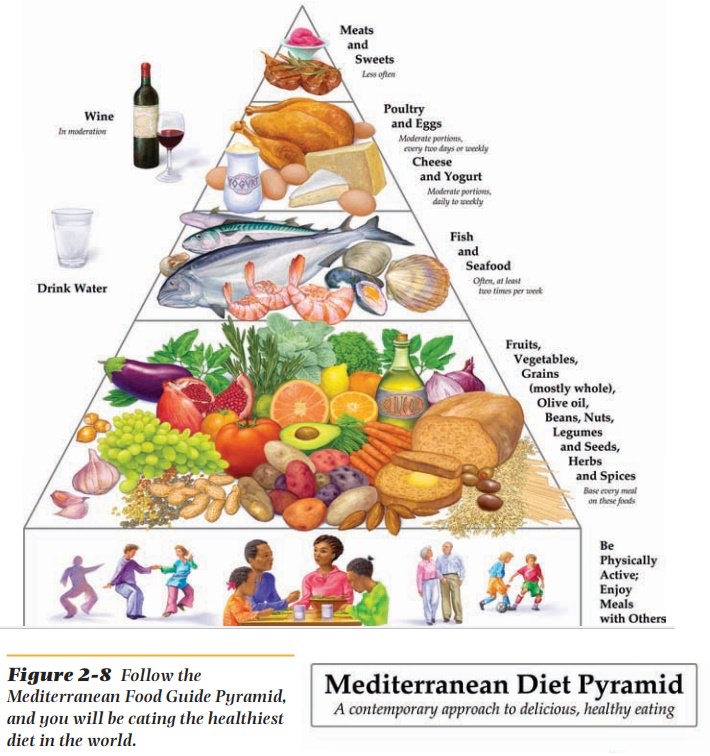
Italian Influence.Italians consume a healthy mix of pasta, rice,
beans,olives, fruits, vegetables, and seafood (Figure 2-9). Beef is seldom
eaten on the Mediterranean side of Italy. Meats such as prosciutto salami,
veal, and pork are favored. Cheese is important in Italian cooking but is often
eaten by itself. Small portions are the norm. The primary fat used is olive
oil. Dessert is usually fresh fruit. The Italians eat their main meal at lunch.
Dinner is a light meal and could be pizza (not the Americanized version).
Adding fat-free milk and low-fat meat would improve their already nutritious
diet.
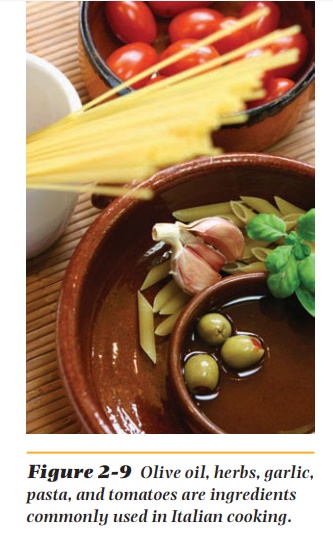
Greek Influence.In the past and even today in remote villages,
theGreeks eat only what is in season at the time (Figure 2-10). Broccoli and
cauliflower were first grown in Greece. Greeks eat salads of wild greens,
artichokes, fava beans, green beans, eggplant, legumes, home-cured olives,
yogurt, and feta cheese. Bread is the basis of a Greek meal, and fruity olive
oil is the primary fat in the Greek diet. Fresh or cured fish and seafood are
abundant and eaten regularly. Meats such as lamb, goat, and pork are also
included in their diet. Dessert usually consists of fresh fruit. The Greeks
have always eaten (and many continue to eat) a Mediterranean diet, but West-ern
influence in the larger cities has changed the eating habits of younger
generations.
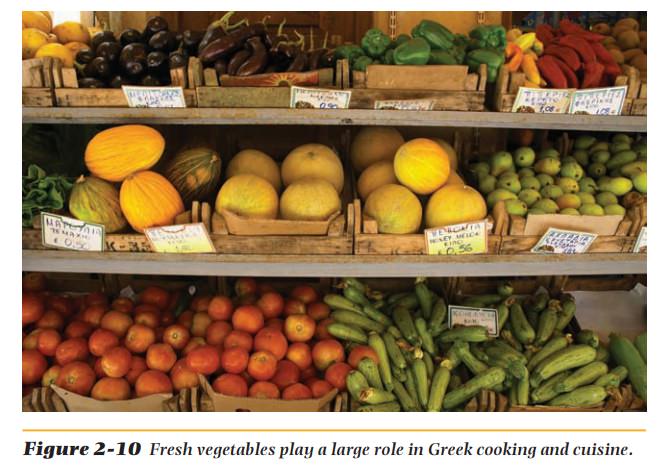
Northern and Western Europe Influences
There are 20 countries in northern and western Europe that have influenced the foods we eat. These countries gave us our “meat and potato” mentality (Figure 2-11). The northern European diet consists of large servings of meat, poultry, or fish with small side dishes of vegetables and starch. Most countries use locally grown foods, such as greens, potatoes, beets, mush-rooms, barley, plums, and rye. Sausages (including blood sausage), head cheese, dark breads, and dairy products are essential food in their diets. Pickled herring is favored in many countries. Some countries in northern and western Europe are extremely cold, limiting the growing season. The addition of fresh fruit and vegetables would add fiber and many vitamins and minerals.
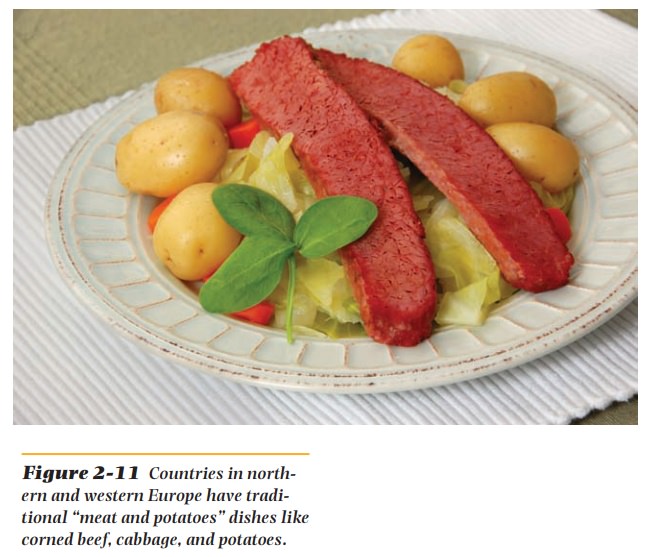
Central European Influences
There are 16 countries
in central Europe, and all of them have very similar cuisines. Pork and chicken
are the most common meats eaten, but beef, sausages, fish, and game are popular
too. Cabbage, sauerkraut, carrots, turnips, potatoes, beans, lentils, and
onions appear in many meals (Figure 2-12). Spatzle, dark breads, and muesli are
main sources of carbohydrates. Eggs and dairy products are used abundantly. Raw
vegetables and fruit would increase vitamins, minerals, and fiber. Fewer eggs
and the use of low-fat or fat-free dairy products would help to decrease fat in
this diet.
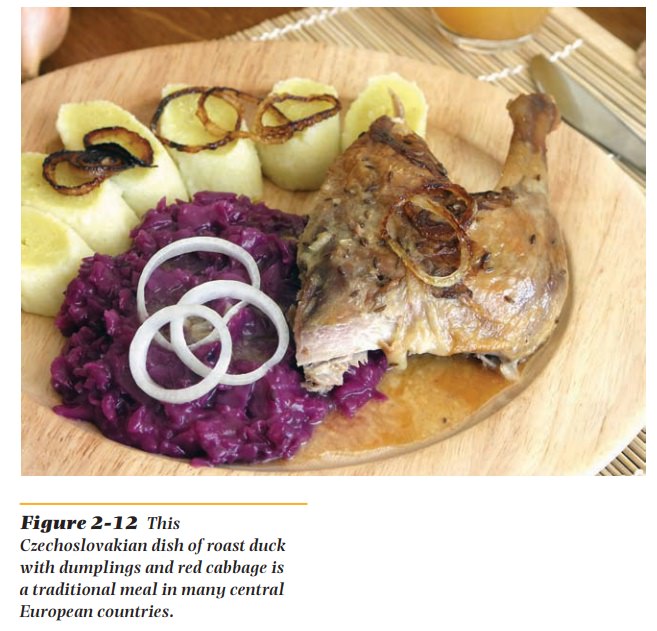
Middle Eastern Influences
The foodways of the Middle East have intertwined and migrated to other coun-tries. Lamb is the primary meat consumed. Pita and flat bread (unleavened) along with sourdough breads are eaten with meals (Figure 2-13). Legumes are an important part of the diet; these include chickpeas (garbanzo beans), which are used to make hummus. Dairy products in the form of yogurt and feta cheese are used extensively. Fortunately, fresh fruit is eaten for snacks and dessert. For centuries, dates and figs have been a staple in this diet. Pistachios are used to make baklava, a very sweet dessert. At the end of a meal, a dense, sweet coffee is served. The addition of fresh vegetables would be desirable to increase vitamins, minerals, and fiber.

Asian Influences
Each Asian country has
its traditional foods. Most familiar is Chinese, but Japanese cuisine is
becoming more available, as are the foods of Southeast Asia. Even though there
may not be a wok in every kitchen, the art of stir-frying has become common
practice. Cutting vegetables in small pieces and cooking them quickly preserves
nutrients. Read the common foods consumed from each country and check how many
you have eaten either at home or at a restaurant.
Chinese Influence.
The Chinese believe that the five essential grains oflife are rice, soybeans, barley, wheat, and millet. Their diet uses many vegeta-bles, such as bean sprouts, shitake and other varieties of mushrooms, broccoli, peppers, snow peas, onions, green beans, bok choy, Napa cabbage, asparagus, chili peppers, seaweed, and cucumber (Figure 2-14). Protein is obtained from seafood, eggs, pork, chicken, beef, and tofu (soybean curd).
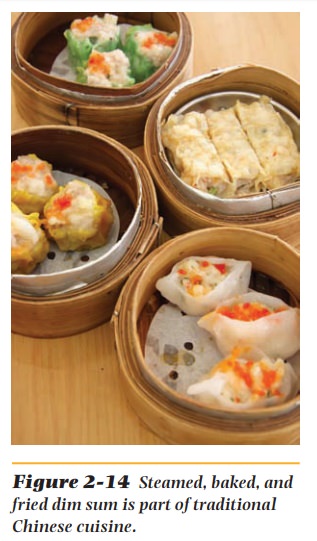
Peanut oil for stir-frying and corn oil
for deep frying are used extensively. Water chestnuts, walnuts, almonds,
cashews, and sesame seeds are used in desserts and stir-fried dishes.
Vegetarianism has expanded since the discovery of tofu. Some of the preferred
seasonings are soy sauce, garlic, and fresh ginger along with various spices. The
use of soy sauce and MSG (monosodium glutamate) may contrib-ute to high blood
pressure. Calcium sources are lacking in this diet, perhaps because of lactose
intolerance in the Asian populations.
Japanese Influence. In ancient times, much of the traditional
Japa-nese cuisine was influenced by the Chinese and Koreans. The medieval
period triggered a gradual transformation with new tastes and flavors. The
Japanese strive to use only the freshest ingredients. Essential ingredients
include bam-boo shoots, tofu, cucumbers, eggplant, enoki and other mushrooms,
spinach, ginger, seaweed, rice, sesame, and green onions. Their protein is from
seafood (both raw and cooked), eggs, and chicken. Seasonings used extensively
are mirin (rice wine with 40–50%
sugar), soy sauce, miso (a thick
fermentedpaste made from soybeans), and wasabi (Japanese
horseradish). Sushi is a well-known food item (Figure 2-15). The Japanese drink
green tea rather than milk. Lactose intolerance plays an important role in
their choices. Fresh fruit is a needed addition.
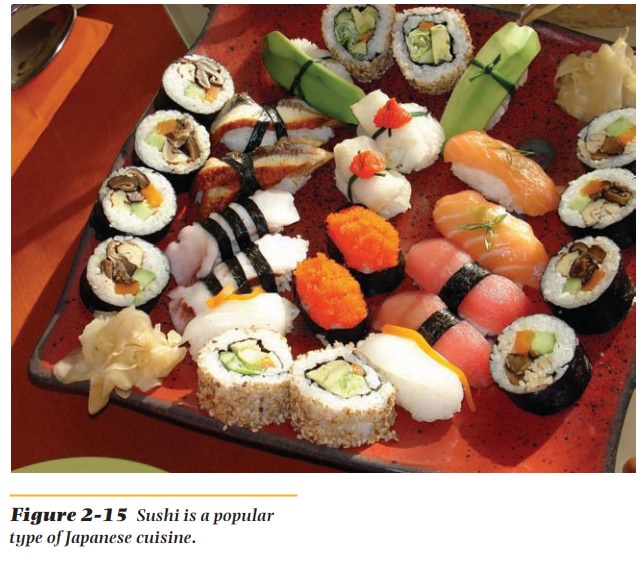
Southeast Asian Influence.
India and China have influenced muchcooking. Many vegetables are eaten because 75% of the population is agriculture based. Rice is the staple food, but noodles are used often (Figure 2-16). Two times as much fish is consumed compared to other meats; pork, chicken, and beef are eaten less often. Southeast Asians prefer coconut milk to any dairy products.

They, like other Asians, use soybean milk, soybean paste, and soy sauce. Fruits
are part of the meals. The inhabitants of Southeast Asia, with the exception of
Vietnam, eat with their fingers, but this is changing. The ginger plant was
first grown here. High blood pressure caused by a high-sodium diet could be an
issue. Soy milk is favored because of lactose intolerance.
Indian Influences.
Religion
and climate are two factors in the develop-ment of food habits in India.
Vegetarianism is very prevalent (over 80%) because of religious beliefs.
Lentils, beans, and milk and milk products supply protein to their diet. The
rest of the population eats small quantities of meat and fish for their
protein. Vegetables grown locally are combined with rice in the south and wheat
products in the north (Figure 2-17). Garlic and eggplants are native to India.
Curry is a spice but also denotes Indian dishes. Eating with your fingersis
acceptable. Oils used in cooking are sunflower, coconut, and mustard oils.
Alack of calcium could be a problem if consumption of milk is inadequate.

New Immigrant Influences
The United States is
made up of immigrants who bring with them wonderful foods that are native to
their country. Immigrants will always prepare their native foods and, it is
hoped, share them with others. Have you ever thought about what traditional
foods your family eats and where they came from?
Somali Influence.No pork is eaten because of religious
doctrine. Someof the foods in the diet are flat bread (Figure 2-18), millet,
cornmeal, rice, noo-dles, bananas, mangoes, papayas, vegetables, liver,
seafood, beans, eggs, pita bread, peanuts, bread, spiced tea with cardamom and
cinnamon bark, chicken, lamb, goat, camel, sheep, and some beef. Frankincense
is native to Somaliland. It is an aromatic gum resin obtained from various
Arabian and East African trees and is chewed after a meal if desired. Lack of
milk and milk products could lead to a calcium deficiency. Liver is an integral
part of their diet but can lead to high cholesterol.
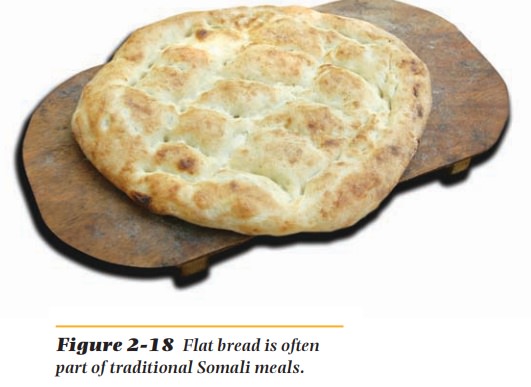
Haitian Influence.African, Spanish, and French culinary
influenceshave shaped Haitian foodways. The Haitian diet is based on starch
staples, such as rice, corn, millet, yams, and beans. Only the wealthy can
afford meat, lobster, shrimp, duck, and sweet desserts. The country’s national
dish is rice and beans (Figure 2-19). Haitians tend to fry their meals in pig
fat (lard) for enhanced flavor. Tropical fruit, such as avocados, mangoes,
pineapples, coconuts, and guava grow abundantly in Haiti. Lack of milk and
dairy products in the diet means that there will be a deficiency of calcium. If
the poor eat only beans and rice with some fruits and vegetables, malnutrition
is a real concern.
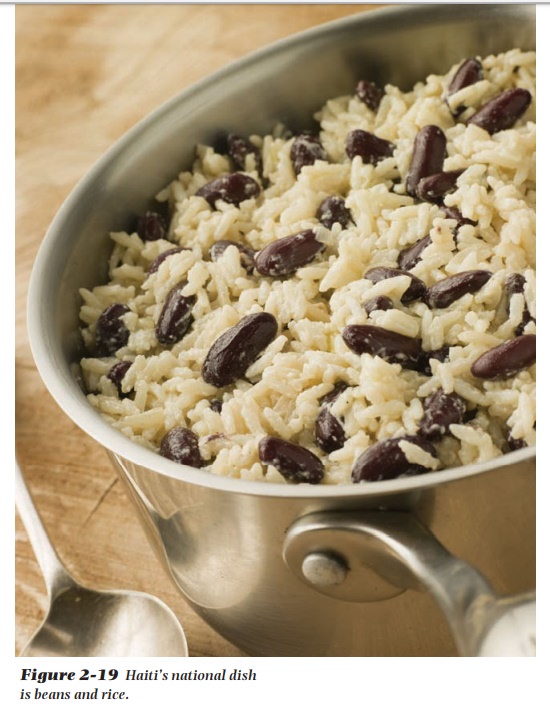
Korean Influence.In Korea the growing of rice dates back to 2000B.C.Millet, soybeans, red beans, and other grains were also produced. Red meat is scarce, but chicken and seafood are abundant. Rice is eaten with every meal, along with vegetables. The national dish of Korea is kimchi, a fermented cab-bage with spices, green onions, and radishes. Kimchi is native to Korea and is served with each meal.
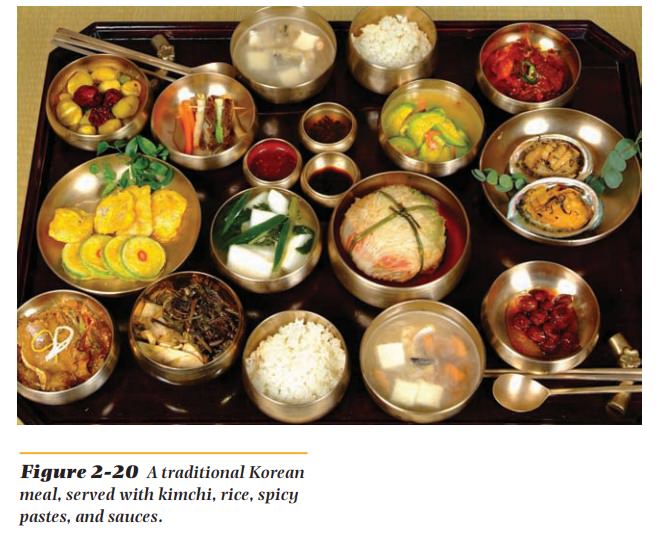
Korean food is very spicy with the use of red pepper
paste, green onion, ginger, garlic, and bean paste (Figure 2-20). Soy sauce is
used extensively. Fresh fruit, such as apples, pears, persimmons, and melons,
or dried fruit are eaten for snacks and dessert. Ninety-nine percent of South
Koreans receive adequate nutrition.
Dominican Republic Influence.Dominican Republic cuisine is a mix of Spanish and Taino Indian. Goat and chicken are the meats eaten most often by local residents (Figure 2-21). Fresh seafood such as shrimp, mahimahi, rock lobster, and marlin are served often in seaside towns. Tropical fruits such as bananas, papayas, pineapples, mangoes, and avoca-dos are eaten often. Plantains, yuca (cassava), chayote, and rice are starchy foods in the diet. Salad is usually eaten with the midday meal. Enjoyed by many is a drink made by adding fruit juice to milk to make a smoothie. Spicy foods are normal in Caribbean countries but not in the Dominican Republic. A wide variety of foods are available, so choosing wisely will pro-vide adequate nutrients.
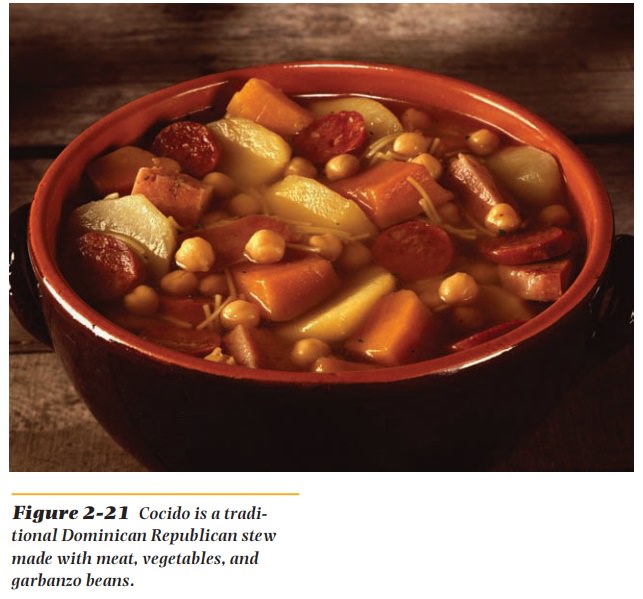
Burmese Influence. The Burmese people have many varieties of
fruitsand vegetables. Tropical fruits abound, such as pineapples, papayas,
oranges, bananas, mangoes, melons, and coconuts. Cabbage, cucumbers,
cauliflower, beets, carrots, bean sprouts, eggplant, kohlrabi, and tomatoes are
just some of the vegetables eaten. Carbohydrate sources are rice, noodles, red
lentils, and mung peas (Figure 2-22). Protein sources are pork, beef, lamb,
chicken, duck, fish or prawns (large shrimp), tofu, and eggs. Vegetable and
fruit salads are popular. Fresh fruits are served for dessert, but sweets are
eaten as snacks or at breakfast. Choosing foods well will ensure good nutrition.
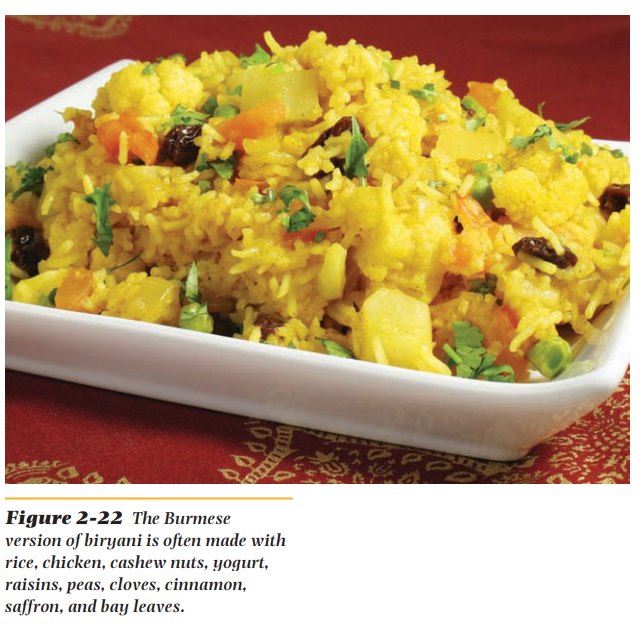
Related Topics